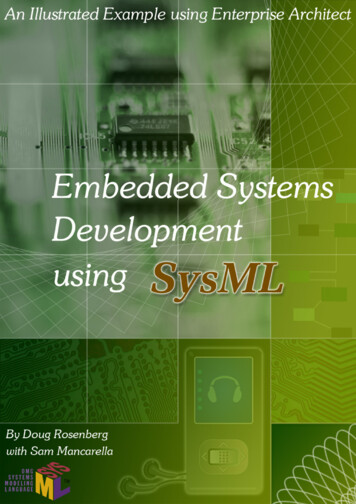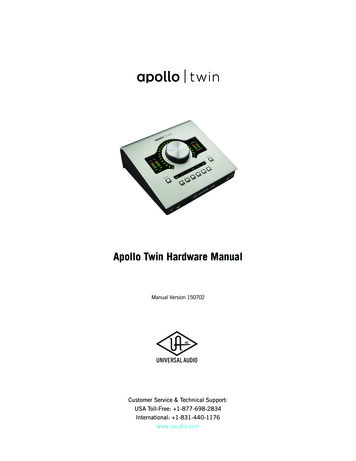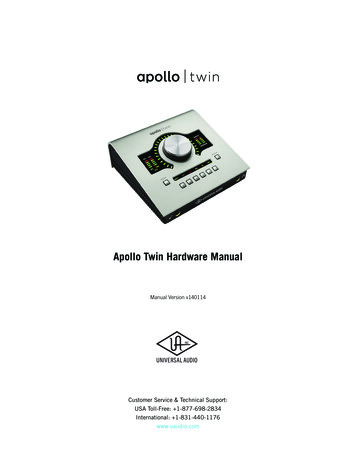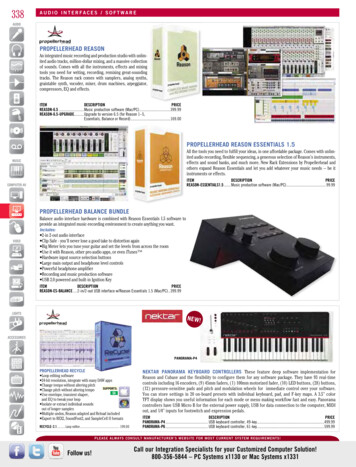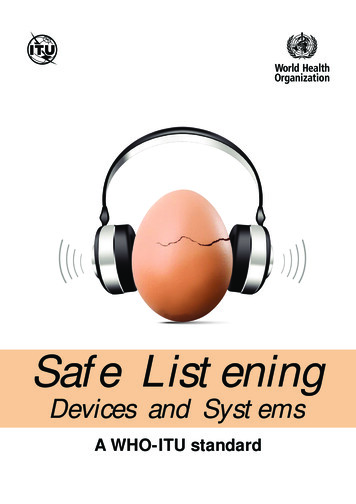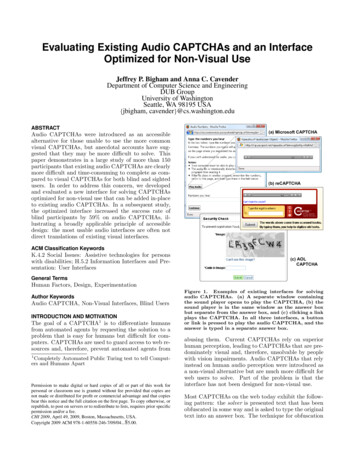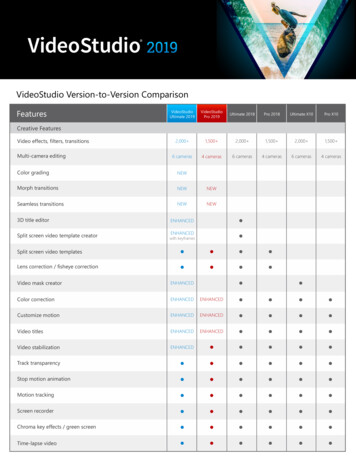
Transcription
3D-Audio with CLAM and Blender’s Game EngineNatanael Olaiz, Pau Arumı́, Toni Mateos and David Garcia.Barcelona Media Centre d’InnovacióAv. Diagonal, 177, planta 9,08018 Barcelona, Spain.{natanael.olaiz, pau.arumi, toni.mateos, david.garcia}@barcelonamedia.orgAbstractBlender can be used as a 3D scene modeler, editor,animator, renderer and Game Engine. This paperdescribes how it can be linked to a 3D sound platform working within the CLAM framework, makingspecial emphasis on a specific application: the recently launched Yo Frankie! open content game forthe Blender Game Engine. The game was hackedto interact with CLAM, implementing spatial scenedescriptors transmited over the Open Sound Controlprotocol, and allowing to experiment with many different spatialization and acoustic simulation algorithms. Further new applications of this BlenderCLAM integration are also discussed.Keywords3D-Audio, CLAM, Blender, Game Engine, VirtualReality1IntroductionThe Blender project [1] has done an impressiveeffort to produce demonstrators of their technologies, such as the Elephants Dream [2] andBig Buck Bunny [3] films for 3D movie production capabilities, and Yo Frankie! [4] forits Game Engine (GE). The needs introducedby those realizations have been a main drivingforce to enhance the platform itself.On the other hand, the CLAM framework [5]has recently incorporated a set of real-time 3Daudio algorithms, including room acoustics simulation, and Ambisonics coding, manipulation,and decoding. This paper discusses an attemptto exploit some of the nice Blender featuresto create an experimental platform that linksBlender, specifically its Game Engine (GE) forthe graphics and interaction part, with CLAMfor the spatialized audio.The linking of Blender and CLAM has beenachieved via the Open Sound Control (OSC [6])protocol and a customized version of the SpatialSound Description Interchange Format (SpatDIF [7]). This architecture still renders bothsystems rather decoupled and independent, providing great flexibility. In particular, it maintains the simplicity of independently changingboth the geometrical elements that define thescenes and the audio algorithms in the CLAMaudio dataflow-based processing networks.Compared to other existing 3D-audio systemsthat integrate in gaming engines, CLAM offers a rich variety of possibilities regarding exhibition systems and room acoustics simulation.For example, the game sound can be exhibitedin multi-loudspeaker setups, not only surround5.1, but virtually any setup, including those using speakers at different heights. It can alsooutput binaural audio for earphones, based onHRTF’s; CLAM uses different binaural techniques and allows switching between differentpublic HRTF’s databases.Moreover, CLAM offers the possibility of performing room acoustics simulation using raytracing techniques, making it possible to recreate very realistic 3D reverberations in real-time.This allows the sound reverberation to dynamically change whenever the sound sources or listener change their positions.The division of responsibilities between thetwo platforms goes as follows: Blender managesthe 3D scene and sends objects positions, orientations and actions to a CLAM processing network. Then, CLAM plays the appropriate audio streams, optionally performing room acoustics simulation, and finally renders the audio tothe desired exhibition system, either a multispeaker setup or headphones. Of course, whenroom acoustics simulation is enabled, CLAM requires a copy of the 3D model used in Blenderto apply its algorithms.Though the system that we present todaystill comprises two rather decoupled applications that communicate though OSC, in the future is likely that CLAM will be integrated intoBlender as a library, similar to (or extending)OpenAL [8]. This would be beneficial in terms
of run-time efficiency, ease of use and softwaredistribution.The paper is organised as follows. We start bydescribing the relevant parts of the Blender engine (section 2) and the CLAM 3D-audio platform (section 3). In section 4 we describe thecommunication between them. Section 5 discusses other uses that this integration provides.In section 6 we present our conclusions and adescription of future work.2BlenderBesides the use as a standard 3D application,the Blender functionalities can be easily extended using Python scripting. Blender includes two main Python APIs: the (bpy) modules for the main editor and preview user interface; and the GameLogic modules for theGame Engine, which allow user interaction andphysics simulations using a simple logic blocksdesign. In what follows we concentrate on thelatter.In the Game Engine, the events are generatedby sensors, and sent to the controllers, whichdecide what action should be performed and interact with the scene either through actuatorsor Python scripts (see fig. 1). Note that thesensors are not only attached to keyboard ormouse events, but to higher level concepts likeproximity to, or collision with, other objects.Although an exhaustive explanation of theYo Frankie! features is outside the scope ofthis paper, suffice it to say that it comprisesthe aforementioned three main components ofthe GE logic. In our implementation, some ofthe sensing events trigger custom Python scriptswithin the controllers block that communicatewith CLAM.Figure 1: Blender Game Engine logic blocks.We use Python scripts to communicate anumber of different data to CLAM. On the onehand, a Python plugin allows to first assignacoustic properties (like impedance or diffusioncoefficients) to the materials present in the geometry, and then export the scene in a formatusable by the room acoustics simulator. Onthe other hand, Python scripts also act as controllers that transmit to the CLAM audio plat-form the necessary information about the soundsources and listener, mostly 3D positions andorientations, and source directivity patterns. Asmentioned above, this communication is basedon the SpatDIF protocol over Open Sound Control.Whereas non-animated sound sources (e.g.trees) have their positions and orientation angles sent over OSC when the user starts the GE,those that are animated and interactive (including the listener) send data constantly. Usuallythe sound sources send a control message of loopsample play, and trigger specific samples whensome special actions are triggered (a kick makesMomo, the monkey, scream, for instance).Although the original game has its ownsounds, and uses OpenAL for a more or lesscomplex processing, the objective was to havea development platform to test and explore different new algorithms (e.g. ray-tracing roomacoustics); this is more easily accomplishedwithin CLAM than within OpenAL, and without hardware requirements.33.13D-Audio in CLAMCLAMCLAM is a C framework for audio processing, with GPL license, created to support audioand music research and rapid application development [5; 9]. Its processing core is based onthe dataflow processing model, where a user defines a system in terms of a graph of processingobjects —or “networks” in CLAM’s nomenclature. One of the particularities of CLAM is thatit supports different token types, such as audio buffers and spectrums, and different portsconsumption rates (e.g. a spectral domain processing may run less times per time unit thanan audio domain processing). The schedulingof CLAM network’s processings can be computed offline, before run-time, using the TimeTriggered Synchronous Dataflow model [10].CLAM supports both real-time and offlineoperation. The first mode allows interactingwith other systems via Jack [11] or embeddingthe network in an audio plugin, of any architecture, such as LADSPA [12]. The secondmode allows defining complex work-flows by using scripting languages, such as Python, andcompute CPU intensive tasks that can not runin real-time.
Figure 3: CLAM network that renders the audio in B-Format.The network depicted in figure 3 shows the processing core of the system. It produces 3D-audiofrom an input audio stream, plus the positionof a source and a listener in a given 3D geometry —which can also be an empty geometry. If the room-simulation mode is enabled,the output audio contains reverberated soundwith directional information for each sound reflection, therefore producing a sensation of being immersed in a virtual environment to theuser.Figure 2: OSC receivers, sampler and spatialization, running with CLAM Prototyper Qt interface.3.2 The 3D-Audio EngineThe following paragraphs describe the mainCLAM networks used in our 3D-audio engine.The format of the output is Ambisonics of agiven specified order [13; 14]. From the Ambisonics format, it is possible to decode theaudio to fit diverse exhibition setups such asHRTF-based audio through headphones, standard surround 5.1 or 7.1, or other non-standardloudspeakers setups. Figure 5 shows a CLAM
1At the moment, the ray-tracing implementation forroom-acoustics simulation is not open-source.GoalIRSlice c 0Slice c 1Slice c 00-PadIRSlice c 2Slice c 30-PadFFTmult0-PadIRConvFFTmult0-PadSlice c 1Slice c 2Implementationnetwork that decodes first order Ambisonics (BFormat) to surround 5.0, whereas the networkin figure 6 decodes B-Format to binaural.Let us describe in more detail the main audio rendering network, depicted in figure 3.The audio scene to be rendered is animatedby a processing which produces controls ofsource/listener positions and angles. This processing can be either an OSC receiver or a filebased sequencer. The picture illustrates thissecond case, where the CameraTracking processing sequences controls from a file (for instance, exported from Blender) and uses an audio input for synchronization purposes.The actual audio rendering process is done intwo stages. The first stage consists on the computation of the acoustic impulse-response (IR)in Ambisonics format for a virtual room at thegiven source/listener positions. This processtakes place in the ImpulseResponseCalculatedOnTheFly processing which outputs the IRs.Since IRs are typically larger than an audioframe they are encoded as a list of FFT frames.The second stage consists on convolving thecomputed IRs, using the overlap-and-add convolution algorithm, which is depicted in figure 4 and explained in [15]. This process is implemented in the Convolution processing whichtakes two inputs: a FFT frame of the incomingaudio stream and the aforementioned IR.The IRs calculation uses acoustic ray-tracingalgorithms 1 , which take into account the characteristics of the materials, such as impedanceand diffusion. The IR calculation is only triggered by the movement of the source or listener,with a configurable resolution.First informal real-time tests have been carried out successfully using simplified scenarios:few sources (3), simple geometries (cube), andfew rays (200) and rebounds (70). We are stillin the process of achieving a physically consistent reverberation by establishing the convergence of our ray-tracer (i.e. making sure thatwe compute enough rays and enough reboundsto converge to a fixed RT60). We will includea discussion on this in further papers. Anotherfuture line is optimize the algorithm for realtime by reusing or modeling reverberation tailsand only compute the early reflections by raytracing.As the diagram shows, each B-Format component (W, X, Y, Z) of the computed IR is pro-0-Pad0-PadIRSlice c 3FFTmult0-Pad0-PadIRFFTmultOverlapand AddIFFTed resultIFFTed resultIFFTed resultIFFTed resultSumSumSumFinal Convolved AudioFigure 4: A schematic description of the partitioned convolution processing object.duced in a different port, and then processed ina pipeline. Each branch performs the convolution between the IR and the input audio, andsmoothes the transitions between different IRsvia cross-fades in the time domain. The need forsuch cross-fades requires doing two convolutionsin each pipe-line.One last source of complexity: since sourcesand listener can move freely, cross-fades are notenough. The result of an overlap-and-add convolution involves two IR’s which, among otherdifferences, present different delays of arrival inthe direct sound and first reflections. Whensuch differences are present, the overlap-andadd will have a discontinuity or clip, which theuser notices as an annoying artifact.This problem has been solved in this case bytaking advantage of the two branches that werealready needed for cross-fading the IR transition. The key point is to restrict how IRs
real ngSpatDIFOSCStorage ascontrol datastreame.g. SDIF, XMLStoringInitial settingsAnnotationsSpatDIF InterpreterLow-level messagesSpatial Sound RendererFigure 5: A simplification of the partitionedconvolution algorithm performed by theCLAM’s “Convolution” processing.change, so that only one branch can be clippedat a time. With this restriction the problemcan be solved by means of the XFade and Delay processings. The Delay processing producestwo IR outputs: the first is just a copy of thereceived IR and the second is a copy of the IRreceived in the previous execution. To ensurethat, at least, one overlap-and-add will be clipfree this processing will “hold” the same outputwhen a received IR object only lasts one frame.The XFade reads the IR objects identifiers —and hence, its 4 input ports— and detects whenand which branch is carrying a clipped frame,to decide which branch to select or to performa cross-fade between the two.In the last step, the listener’s orientation isused to rotate the B-Format accordingly. Therotated output is then ready to be streamed toone or more decoders for exhibition systems.4Communication between Blenderand CLAM via SpatDIFFor the OSC interaction, we used the SpatDIFprotocol, which aims at establishing an openstandard interchange format for spatial sounddescription [16], illustrated in figure 7. The definition of SpatDIF is still work in progress, giventhe fact that at the moment the major publishedinformation have been only its goals and a fewuse examples [7]. The present implementationfor the GameEngine-CLAM OSC communication has made use of a subset of the SpatDIFstandard, extended to cope with the needs mentioned in this paper. We plan to suggest thatsome of these extensions be added to SpatDIF,and expect to implement full use of this standard when finished, including its non-real timeimplementation.Figure 7: SpatDIF work blocks diagram.Copied from Proposing SpatDIF - The SpatialSound Description Interchange Format. [16]with author permissionFor the sake of illustration, let us presentsome examples of SpatDIF messages used: /SpatDIF/source/n/xyz (x-axis y-axis z-axis ;floats) /SpatDIF/source/n/aed (azimuth elevationdistance ; floats)Both examples describe the position of a soundsource n. The first uses absolute coordinateson a 3D reference system, whereas the seconduses spherical coordinates. Note that, in ourimplementation, besides the use of an integer,it is also possible to use a string to univocallyrefer to an object name.Examples related to source orientation andpattern directivity are : /SpatDIF/source/n/aer (azimuth elevation roll ;floats) /SpatDIF/source/n/emissionPattern (e, wheree can be either a string or an integer,pointing to one of the source emission patterndirectivities of a given table, e.g. omni orcardioid)We have also needed to send setup/triggeringmessages to control a sampler based sound,working with layers, and allowing any soundsource to trigger more than one sample at agiven time. Some examples: /SpatDIF/source/n/sampler/addLayer (name ;string) /SpatDIF/source/n/sampler/name/setBuffer (audiofile name ; string, to define the sampler layer
Figure 6: CLAM network that converts 3D-audio in B-Format to 2 channels binaural, to be listenedwith headphones. The technique is based in simulating how the human head and ears filters theaudio frequencies depending on the source direction.used sound file) /SpatDIF/source/n/sampler/name/setLoop (bool ;sampler layer loop configuration) /SpatDIF/source/n/sampler/name/play (bool ;play/stop control)For the purpose of real time preview on Blender(not Game Engine), we have incorporated aframe sync message as follows: /SpatDIF/FrameChanged (number of frame ;integer)Another extension was needed to define an initial setup message to add sources, analog to thework of the sampler addLayer one: /SpatDIF/source/addSource (name ; string)In a future extension, it would be desirable tostandardize a format for geometry and acousticproperties of materials suitable for room acoustics calculations. This would enable the communication of such data when the Game Enginestarts, thus avoiding the initial offline exportation.5Other usesGiven that the Game Engine allows realtime user interaction with good quality imageOpenGL rendering, and given that the correspondent CLAM Networks can do the counterpart for audio, we think that the following usecases make a fruitful use of this integration, andwe are experimenting with them.5.1 Real-time animation previewThe main user interface of Blender allows thecreation, manipulation and previewing of ascene (objects and animations) in real-time and,as in the Game Engine, with an OpenGL rendering quality. Using almost the same aforementioned scripts, it is also possible to send thepositions and orientations of objects defined aslisteners and sources in real time, thus providing a new powerful 3D sound spatializator editor interface and previewer. In this sense, wecan think of the Blender-CLAM integration asa kind of what you see if what you hear editor.5.2 High quality offline renderingThe Blender-CLAM integration offers an audiocounterpart of high-quality offline image rendering. As mentioned above, besides sound
sources and listener data, the CLAM spatialization plugin includes exporters of Blender geometries with acoustic parameters associated tothe materials present in the scene. Using theCLAM OfflinePlayer, it is possible to generate high quality offline room acoustics simulations, which recompute the corresponding reverb every time a source or the listener moves.The result of the offline rendering, which canbe in Ambisonics format with any given order, can then be used as an input on a Digital Audio Workstation (DAW) for further postproduction. At the moment, we use ArdourLADSPA plugins developed for that purpose.For this offline application, we are indeed using an specific CLAM file format which contains all the parameters describing the motionof sources and listener at each video frame, thezoom of the camera, etc. In the mid-term, weplan to use the same SpatDIF format in bothreal-time and offline applications (fig. 7).Figure 8: Exportation of Blender scene geometries and animations.5.3 Head-tracking and motion sensorsOne interesting possibility to explore with thisplatform is the use of motion sensors to interact with Blender. For instance, head-trackingapplied to binaural simulations improve the interactive 3D sound immersive experience. Another example is the use of a tracker to definethree-dimensional trajectories that can be assigned to objects in the scene with the aim ofspatializing the sound associated to them. Thiscan be thought of a sort of 3D extension of thejoysticks used in DAWs for panning sounds.6Conclusions and future workIt has been shown that combining Blender andCLAM is useful to render 3D-audio by manipulating 3D scenes, and it provides a flexible andFigure 9: Combining Yo Frankie! with headtracking.powerful platform for experimenting with different acoustic field rendering techniques andexhibition setups.An interactive game and several short movieshave already been produced using these tools inthe Barcelona Media audio lab. The game is amodified version of Blender’s Yo Frankie!, whichcommunicates the position and sound events ofthe actors to CLAM using an OSC based protocol. The short movies have been post-producedusing Blender for 3D animation and a plugindeveloped to associate geometric objects withsound sources and finally export this data foroffline audio rendering using CLAM.The 3D-audio for both the game and the shortmovies has been exhibited in different setups,including binaural, stereo, 5.1, and a custom15-loudspeakers setup, the latter distributed asfollows: six in a central rig, four in a upperrig, four in a lower rig and one speaker on top(see fig. 10). For these initial tests, the audiohas been decoded using VBAP and first orderambisonics (B-Format), but other techniquesthat make a better use of a large number ofloudspeakers are currently being implemented,among these, higher order Ambisionics.Initial informal tests have been performedwith people from the audio-visual industry ingeneral and sound design in particular, and theresults have been so far encouraging.The rationale behind the use of a 3D graphics tool, such as Blender, for audio purposes isthat most of today’s audio-centric tools used byprofessionals in media post-production, such asDigital Audio Workstations (DAW’s), largely
tions deployment. However, this is work shouldbe done only once the system is mature enoughand with stable functionalities.AcknowledgementsThis work is supported by the European UnionFP7 project 2020 3D Media (ICT 2007) and bythe Google Summer of Code 2008 program. Weare specially thankful to all CLAM and Blenderdevelopers.References[1] Blender Foundation. Blender main website.http://www.blender.org/.Figure 10: Picture of the arrange of 15 speakersused whithin the development.lack support for geometric metaphors. It islikely that the increasing interest of the industry for 3D cinema and TV will also push the interest for 3D-audio content, which in turn, willdemand for new or modified audio tools. Webelieve that a simplified set of Blender’s features allowing for scene manipulation shall beincorporated into the DAW’s core features, allowing the production of 3D-audio content independently of the final exhibition format (suchas 5.1, 22.2, binaural or Wave Field Synthesis).The presented work still has many open lines.First, more encoding and decoding algorithmssuch as higher order Ambisonics (specially innon-regular setups) should be tested within thereal-time game. Second, the way sound samplers are set up in CLAM should be mademore flexible. As it stands, the addition ofmore sound sources (and hence, samples) implies manually modifying a CLAM network. Inshort, this CLAM network setup will be doneautomatically by means of the proposed SpatDIF protocol extension, transmitting the sceneinformation from Blender to CLAM. Third, nonpunctual sound sources should be implemented,for example, a river. In this case the soundshould emanate from all points in a line (theriver) instead of a single point, possibly incorporating decorrelation algorithms to increase itsspatial extend perception [17]. Fourth and last,all the audio functionality could be encapsulated into a library with a well defined interface,maybe using and extending the OpenAL API.This would probably enable enhanced run-timeperformance, easier reuse and better applica-[2] reamopen movie main website.http://orange.blender.org/background.[3] Blender Foundation. Big buck bunnyopen movie main website. http://www.bigbuckbunny.org/index.php/about/.[4] Blender Institute. Yo -apricot.[5] X. Amatriain, P Arumi, and Garcia D. Aframework for efficient and rapid development of cross-platform audio applications.ACM Multimedia Systems, 2007.[6] /opensoundcontrol.org/introduction-osc.[7] Nils Peters et all. Spatdif main website.http://spatdif.org/.[8] Creative Labs. Openal main ault.aspx.[9] CLAM team. Clam framework main website. http://clam.iua.upf.edu.[10] P. Arumi and X. Amatriain. Timetriggered Static Schedulable Dataflows forMultimedia Systems. Proceedings of Multimedia Computing and Networking, 2009.[11] P. Davis, S. Letz, Fober D., and Y. Orlarey. Jack Audio Server: MacOSX portand multi-processor version. In Proceedingsof the first Sound and Music Computingconference - SMC04, pages 177–183, 2004.[12] Linux Audio Developers. Ladspa mainwebsite. http://www.ladspa.org/.
[13] M. A. Gerzon. Periphony: With-heightsound re-production. Journal of the Audio Engineering Society, 21:2–10, January1973.[14] D.G. Malham and A. Myatt. 3-d soundspatialization using ambisonic techniques.Computer Music Journal, 19(4):58–70,1995.[15] A. Torger and A. Farina. Real-time partitioned convolution for ambiophonics surround sound. Institute of Electrical andElectronics Engineers, 2001.[16] Nils Peters. Proposing spatdif - the spatial sound description interchange format.International Computer Music Conference,2008.[17] G. Potard and I. Burnett. Control andmeasurement of apparent sound sourcewidth and its applications to sonificationand virtual auditory displays. Sydney, Australia, 2004. International Community forAuditory Display (ICAD), InternationalCommunity for Auditory Display (ICAD).
the sensing events trigger custom Python scripts within the controllers block that communicate with CLAM. Figure 1: Blender Game Engine logic blocks. We use Python scripts to communicate a number of di erent data to CLAM. On the one hand, a Python plugin allows to rst assign acoustic properties (like impedance or di usion

